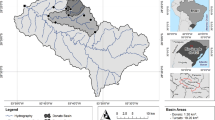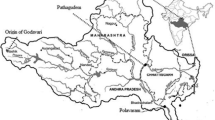Abstract
The applicability of artificial neural networks (ANNs) and the adaptive neuro-fuzzy inference system (ANFIS) for determination of mean velocity and discharge of natural streams is investigated. The 2,184 field data obtained from four different sites on the Sarimsakli and Sosun streams in central Turkey were used in the study. ANNs and ANFIS models use the inputs, water surface velocity and water surface slope, to estimate the mean velocity and discharges of natural streams. The accuracies of both models were compared with the multiple-linear regression (MLR) model. The comparison results showed that the ANFIS model performed better than the ANNs and regression models for estimating mean velocity and discharge. The ANN model also showed better accuracy than the MLR model. The root mean square errors (RMSE) and mean absolute relative errors (MARE) of the MLR model were reduced by 88 and 91 % using the ANFIS model in estimating discharges, respectively. It is found that the optimal ANFIS model with RMSE of 0,063, MARE of 3,47 and determination coefficient (R2) of 0,996 in the test period is superior in estimation of discharge than the MLR model with RMSE of 0,532, MARE of 38,9 and R2 of 0,776, respectively. The study reveals that the ANFIS technique can be successfully used for estimating the mean velocity and discharge of natural streams by using only the inputs of water surface velocity and water surface slope.








Similar content being viewed by others
References
Ardiclioglu M, Genc O, Kalin L, Agiralioglu N (2012) Investigation of flow properties in natural streams using the entropy concept, Water and Environ J, Print ISSN 1747–6585
ASCE Task Committee (2000) Artificial neural networks in hydrology. Preliminary concepts. J Hydrol Eng ASCE 5(2):115–123
Bilhan O, Emiroglu ME, Kisi O (2010) Application of Two different neural network techniques to lateral outflow over rectangular side weirs located on a straight channel. Adv Eng Softw 41(6):831–837
Chow VT (1959) Open channel hydraulics. McGraw—Hill Book Co., New York
Chu HJ, Chang LC (2009) Application of optimal control and fuzzy theory for dynamic groundwater remediation design. Water Resour Manag 23(4):647–660
Cobaner M, Seckin G, Kisi O (2008) Initial assessment of bridge backwater using artificial neural network approach. Can J of Civ Eng 35(5):500–510
Dawson WC, Wilby R (1998) An artificial neural network approach to rainfall-runoff modeling. Hydro Sci J 43(1):47–66
Dogan E, Yuksel I, Kisi O (2007) Estimation of sediment concentration obtained by experimental study using artificial neural networks. Environ Fluid Mech 7:271–288
Emiroglu ME, Kisi O (2013) Prediction of discharge coefficient for trapezoidal labyrinth side weir using a neuro-fuzzy approach. Water Resour Manag 27(5):1473–1488
Emiroglu ME, Kisi O, Bilhan O (2010) Predicting discharge capacity of triangular labyrinth side weir located on a straight channel by using an adaptive neuro-fuzzy technique. Adv Eng Softw 41(2):154–160
Emiroglu ME, Bilhan O, Kisi O (2011) Neural networks for estimation of discharge capacity of triangular labyrinth side-weir located on a straight channel. Expert Syst Appl 38(1):867–874
Haykin S (2009) Neural networks and learning machines, 3rd edn. Prentice Hall, New Jersey
Iglesias C, Torres JM, Nieto PJG, Fernández JRA, Muñiz CD, Piñeiro JI, Taboada J (2014) turbidity prediction in a river basin by using artificial neural networks: a case study in northern Spain. Water Resour Manag 28:319–331
Jang JSR (1993) ANFIS: adaptive-network-based fuzzy inference system. IEEE Trans Syst Manag Cybern 23(3):665–685
Jang JSR, Sun C-T, Mizutani E (1997) Neuro-fuzzy and soft computing: a computational approach to learning and machine intelligence. Prentice Hall, Upper Saddle River
Kisi O (2005) Suspended sediment estimation using neuro-fuzzy and neural network approaches. Hydro Sci J 50(4):683–696
Kisi O (2007) Stream flow forecasting using different artificial neural network algorithms. J Hydrol Eng ASCE 12(5):532–539
Kisi O, Bilhan O, Emiroglu ME (2013) ANFIS to estimate discharge capacity of rectangular side weir. Water Manag 166:479–487, WM9
Kocabas U, Ulker S (2006) Estimation of critical submergence for an intake in a stratified fluid media by neuro-fuzzy approach. Environ Fluid Mech 6:489–500
Kocabas F, Kisi O, Ardiclioglu M (2009) An artificial neural network model for prediction of critical submergence for an intake in a stratified fluid media. Civ Eng Environ Syst 26(4):367–375
Maier HR, Dandy GC (2000) Neural networks for the prediction and forecasting of water resources variable: a review of modeling issues and application. Environ Model Softw 5:101–124
Mamak M, Seckin G, Cobaner M, Kisi O (2009) Bridge afflux analysis through arched bridge constrictions using artificial intelligence methods. Civ Eng Environ Syst 26(3):279–793
Maria CM, Wenceslao GM, Manuel FB, José MPS, Román LC (2004) Modeling of the monthly and daily behavior of the discharge of the xallas river using Box–Jenkins and neural networks methods. J Hydrol 296:38–58
Marques CAF, Ferreira J, Rocha A, Castanheira JM, Gonçalves P, Vaz N, Dias JM (2006) Singular spectral analysis and forecasting of hydrological time series. Phys Chem Earth 31:1172–1179
Pulido-Calvo I, Portela MM (2007) Application of neural approaches to one-step daily flow forecasting in Portugues watersheds. J Hydrol 332(1–2):1–15
Salas JD, Tableios GQ, Bartolini P (1985) Approaches to multivariatemodeling of water resources 19 time series. Water Resour Bull 21(4):683–708
Yang HC, Chang FJ (2005) Modelling combined open channel flow by artificial neural networks. Hydrol Process 19:3747–3762
Author information
Authors and Affiliations
Corresponding author
Rights and permissions
About this article
Cite this article
Genç, O., Kişi, Ö. & Ardıçlıoğlu, M. Determination of Mean Velocity and Discharge in Natural Streams Using Neuro-Fuzzy and Neural Network Approaches. Water Resour Manage 28, 2387–2400 (2014). https://doi.org/10.1007/s11269-014-0574-6
Received:
Accepted:
Published:
Issue Date:
DOI: https://doi.org/10.1007/s11269-014-0574-6




